Most Web users probably use at least one Yahoo product on a regular basis. So as part of our 100 Days For Yahoo week, let’s take a look at 10 that are among the leaders in their particular market segment, or are particularly innovative. These are subjective selections, because it’s almost impossible to use objective criteria to judge such different web properties. So we encourage you to comment on what you think should be in the list, or what shouldn’t. Also note that the following list is in no particular order.

1. Yahoo News is the number 1 Internet news site, according to comScore. It is a blend of automated and editorial, and also offers a number of personalization options. As Josh Catone explained in a recent R/WW post about news aggregation, Yahoo! takes news from the wires — the Associated Press, Reuters, AFP, and PA SportsTicker, among others — and aggregates them into a single stream. Editors keep duplicates to a minimum and decide which stories are the most important to be listed as top headlines. This mix of technology and editors creates a high quality news stream, albeit lacking the immediacy of blogs.

2. Answers allows users to search for things that don’t yet have an answer. This is a key strategic product for Yahoo, because using ‘people power’ is one way Yahoo can take on Google in search. Social search is the catchphrase and it was something I discussed withYahoo’s Bradley Horowitz and Caterina Fake a year ago at the Supernova conference. They told me how Yahoo Search is evolving into a more social construct. At that stage there were approximately 10 Million Y! Answers in the database, although I’m sure it’s much more than that now.
And if you think Answers will never enable Yahoo Search to compete with Google, check out our recent story about how South Korean search company Naver.com is crushing Google in the South Korea market, largely due to Naver’s “Knowledge iN” real-time question-and-answer platform – which gets an average of 44,000 questions a day. Long way to go before Yahoo gets that kind of uptake with Answers, but still it remains a key product for Yahoo.
See also R/WW’s round-up of Q&A sites.
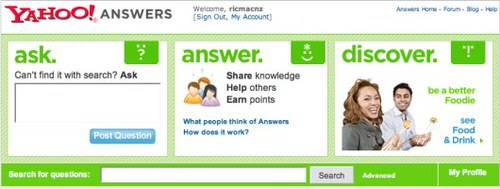
3. Flickr has been the web 2.0 poster child of photo sharing sites ever since it was released. When it was acquired in March 2005 by Yahoo, it continued to make incremental upgrades. Indeed at the 2007 Webby Awards (the Web’s Oscars), Flickr picked up 3 awards (5 including two Peoples Choice ones), for Best Practices, Best Visual Design – Function, and Community.

Despite Flickr’s impressive design and innovation, it has been somewhat overshadowed by Photobucket in terms of user numbers and traffic – thanks mainly to Photobucket piggy-backing off MySpace’s success. However, as the below graph from Compete shows, Flickr has started to make big gains – and it’s now almost caught up to Photobucket.
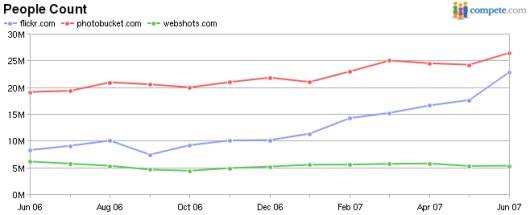
4. Pipes – Yahoo released an RSS Remixing service called Pipes in February 2007. At launch it was described as “an interactive feed aggregator and manipulator”. Basically it’s a hosted service that enables you to create remix feeds and create new data mashups in a visual programming environment.
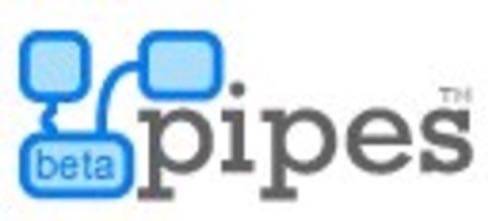
R/WW Author Alex Iskold was very impressed with Pipes, saying that it’s the first GUI builder for the biggest database in the world – the Web iself. Alex said that when compared to Visual Basic and Power Builder, Yahoo! Pipes comes out as more inventive and no less rigorous that its predecessors. It empowers developers to remix the building blocks of the web in a whole new way. And it does it with remarkable simplicity.
5. Yahoo Mail – in most stats Yahoo Mail is the number 1 web mail product. However when the new Ajax version of Yahoo! Mail was released as a beta in September last year, it was certainly late to market. Gmail had been wowing geeks since April 2004, so it was a long wait until Yahoo! Mail caught the Ajax bug too. Which was odd, because it was based on an Ajax pioneer which Yahoo acquired in July 2004 – called Oddpost. But as Yahoo’s Ethan Diamond explained to me back in September, when you roll out Ajax to 250M or so mainstream users, you need to make sure everything scales.

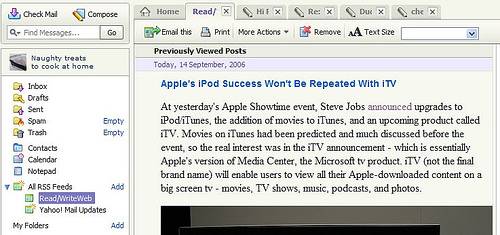
Yahoo Mail has the functionality of a desktop email client (such as Outlook). Other features include an integrated calendar timeline (including mashups with Yahoo Maps), drag and drop e-mail organization, message preview, tabs for messages, plus an integrated RSS reader. Also an API was released in March 2007. While it’s not my favorite web mail service (see R/WW’s Web Email Market Overview to find out what is!), Yahoo’s option is great for those who like the desktop email paradigm.
6. Messenger (with Avatars). Yahoo’s Instant Messenging product is one of the market leaders, but more importantly it is a lot of fun to use thanks to its avatars. It also has voice and many plug-ins.

Many people use multiple IM clients (and use meta IM services like Meebo and Trillian to manage that). And IM innovation has been strong in the past few years – common features these days include interoperability, flexible identities, rich media chat, in-browser chat, location-based chat, and contextual chat. So whatever IM client you use, there is a lot you can do with them on the Web.
7. Yahoo Music is a colorful and feature-rich online music service. Just today they released playlists, a new samples player, and web subscription playback. Yahoo acquired Webjay, an innovative playlisting startup, back in January 2006. So it’s great to see playlisting make an appearance now in Yahoo Music. The new playlist functionality was described by Lucas Gonze (founder of Webjay) as “a full-featured module which includes the ability to play tracks and to comment on playlists. You can browse playlists by creator and you can browse playlists which a person has commented on, so there is a content-focused social network.”

8. del.icio.us – As Alex Iskold wrote in the R/WW Social Bookmarking Faceoff in September, it could be argued that the current social web era started with del.icio.us and the advent of social bookmarking. The simple concept of a tag has turned our interactions with the web upside down. The idea of being able to store your bookmarks online, share them with everyone and see what others have bookmarked – triggered the sequence of events that resulted in today’s rich and social web ecosystem.

Yahoo acquired del.icio.us in December 2005 and, like Flickr, it has iterated in small steps since then. There was initially talk that del.icio.us would integrate with Yahoo’s other bookmarking service, My Web 2.0. But that never happened. In the end, del.icio.us has stayed pretty much independent – which is exactly how its many fans like it.
9. Yahoo Mobile – Yahoo OneSearch launched in January this year and then became the default mobile Yahoo homepage in March. This made it a purely search-centric homepage for mobile phones, whereas the old site had both search and a kind of mini-portal. There is a lot of added functionality in oneSearch; it tries to provide context when searching for something on your mobile phone, recognizing that on a phone you need different types of info than on a PC.

According to the December 2006 stats from M:Metrics, Yahoo! Search is currently the #2 search service on mobile phones for the US market – behind Google. It is obviously a growth market and Yahoo is bringing a lot of web functionality to its mobile property.
10. My Yahoo – last, but certainly not least, is My Yahoo. In many ways a precursor to the current crop of ‘personalized start pages’, My Yahoo is now taking on many of their attributes. As we noted in our March 2007 coverage of My Yahoo!’s Web 2.0 Makeover, My Yahoo! has been the company’s personalized offering to its consumers since 1996. It is seen as the company’s “narrowcast” option for users, while the yahoo.com frontpage is seen as the broadcast model. However over time, the two homepages will converge. Indeed the beta My Yahoo has some of the new features Yahoo introduced last year with its Ajax makeover of yahoo.com. And the look and feel is very similar between the two.
Up until the re-design in March, My Yahoo was a relatively static personalized homepage – mostly devoid of the widgets and gadgets that populate the likes of Netvibes and Live.com. However that is beginning to change, albeit very slowly compared to its startup competition.
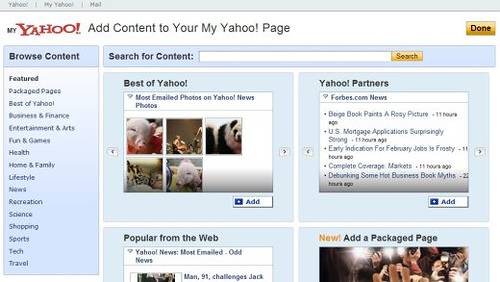
Bonus
Yahoo Shopping just missed the Top 10, but nevertheless is has a lot of potential. Yahoo has just started to scratch the surface, with experiments like Brand Universe and Yahoo Shoposphere. The latter has a concept called ‘me-commerce’ and uses “Pick Lists” to let users share their stuff on the Shoposphere and Yahoo! Shopping – using email and RSS feeds. Yahoo Shopping also has an API, which is being used by companies like ShoppingPath.com, a shopping comparison service.
But there’s so much more Yahoo can do with Y! Shopping – they could look to RSS and widget shopping startups to see what is happening in this domain [disclosure: I am an advisor at one such startup].

Conclusion
There were some obvious Yahoo properties that we haven’t listed – for instance there was no room for Upcoming, Y! Games, Y! Finance or Y! Personals. All of those (and many more) are great services.
What do you think of this list – does it capture the best Yahoo products? What other Yahoo properties do you use, or what do you think needs improvement before you’d consider using it?










